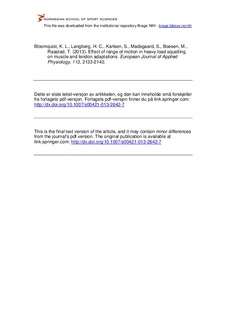| dc.contributor.author | Bloomquist, K. | |
| dc.contributor.author | Langberg, H. | |
| dc.contributor.author | Karlsen, S. | |
| dc.contributor.author | Madsgaard, S. | |
| dc.contributor.author | Boesen, M. | |
| dc.contributor.author | Raastad, Truls | |
| dc.date.accessioned | 2014-09-05T12:34:56Z | |
| dc.date.available | 2014-09-05T12:34:56Z | |
| dc.date.issued | 2013-04-20 | |
| dc.identifier.citation | European Journal of Applied Physiology. 2013, 113, 2133-2142 | nb_NO |
| dc.identifier.uri | http://hdl.handle.net/11250/218859 | |
| dc.description | I Brage finner du siste tekst-versjon av artikkelen, og den kan inneholde ubetydelige forskjeller fra forlagets pdf-versjon. Forlagets pdf-versjon finner du på link.springer.com: http://dx.doi.org/10.1007/s00421-013-2642-7 / In Brage you'll find the final text version of the article, and it may contain insignificant differences from the journal's pdf version. The definitive version is available at link.springer.com: http://dx.doi.org/10.1007/s00421-013-2642-7 | nb_NO |
| dc.description.abstract | Manipulating joint range of motion during squat training may have differential effects on adaptations to strength training with implications for sports and rehabilitation. Consequently, the purpose of this study was to compare the effects of squat training with a short vs. a long range of motion. Male students (n = 17) were randomly assigned to 12 weeks of progressive squat training (repetition matched, repetition maximum sets) performed as either a) deep squat (0–120° of knee flexion); n = 8 (DS) or (b) shallow squat (0–60 of knee flexion); n = 9 (SS). Strength (1 RM and isometric strength), jump performance, muscle architecture and cross-sectional area (CSA) of the thigh muscles, as well as CSA and collagen synthesis in the patellar tendon, were assessed before and after the intervention. The DS group increased 1 RM in both the SS and DS with ~20 ± 3 %, while the SS group achieved a 36 ± 4 % increase in the SS, and 9 ± 2 % in the DS (P < 0.05). However, the main finding was that DS training resulted in superior increases in front thigh muscle CSA (4–7 %) compared to SS training, whereas no differences were observed in patellar tendon CSA. In parallel with the larger increase in front thigh muscle CSA, a superior increase in isometric knee extension strength at 75° (6 ± 2 %) and 105° (8 ± 1 %) knee flexion, and squat-jump performance (15 ± 3 %) were observed in the DS group compared to the SS group. Training deep squats elicited favourable adaptations on knee extensor muscle size and function compared to training shallow squats. | nb_NO |
| dc.language.iso | eng | nb_NO |
| dc.publisher | Springer Verlag | nb_NO |
| dc.subject | resistance training | nb_NO |
| dc.subject | hypertrophy | nb_NO |
| dc.subject | patellar tendon | nb_NO |
| dc.subject | jumping performance | nb_NO |
| dc.title | Effect of range of motion in heavy load squatting on muscle and tendon adaptations | nb_NO |
| dc.type | Journal article | nb_NO |
| dc.type | Peer reviewed | nb_NO |
| dc.subject.nsi | VDP::Mathematics and natural science: 400::Basic biosciences: 470 | nb_NO |
| dc.source.journal | European Journal of Applied Physiology | nb_NO |
| dc.description.localcode | Seksjon for fysisk prestasjonsevne / Department of Physical Performance | nb_NO |
